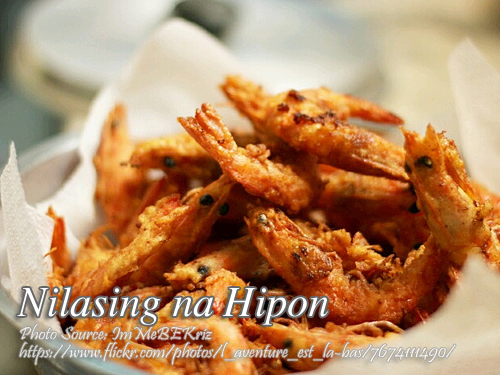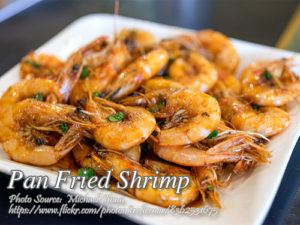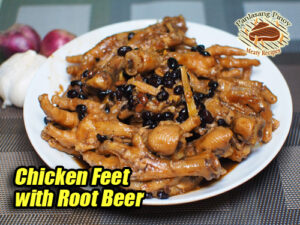Nilasing na hipon or drunken shrimps is actually battered fried shrimps and marinated with Worcestershire Sauce, red chili, salt with a mixture of alcoholic beverage like gin or beer. The shrimps are not peeled and fried whole so you have to make sure the shells are crispy enough before removing it from the frying pan.
Nilasing na Hipon: A Taste of Filipino Comfort
Whenever I think of nilasing na hipon, I’m transported back to lazy summer afternoons at my Tito Boy’s house in Batangas. The salty breeze from the sea, the sound of cousins laughing as they played outside, and the aroma of fried shrimp wafting from the kitchen made those moments unforgettable. My auntie Lydia would whip up this dish with her signature flair, often pairing it with ice-cold beer for the adults and freshly squeezed calamansi juice for us kids.
This recipe for drunken shrimps is a beloved classic in many Filipino households. It’s a delightful combination of simplicity and indulgence, perfect as an appetizer or even a main dish when paired with steamed rice. But it’s more than just food—it’s a reminder of family gatherings, heartfelt laughter, and the comforting flavors of home.
What Makes Nilasing na Hipon Special?
At its heart, nilasing na hipon is battered and fried shrimp. What sets it apart is the marinade. The shrimp are soaked in a flavorful mixture of Worcestershire sauce, garlic, salt, pepper, and chili, with a generous splash of gin or beer. This is where the “drunken” part comes in, giving the dish its distinct taste.
The use of alcohol isn’t just for show—it serves a purpose. Beer or gin tenderizes the shrimp, infusing it with a subtle sweetness and depth that elevates its natural flavors. When fried to golden perfection, the marinated shrimp develop a crisp, flavorful shell that’s as addictive as the tender meat inside.
A Quick History of Nilasing na Hipon
The dish’s name, which translates to “drunken shrimp,” reflects its primary ingredient: alcohol. While there’s no clear record of its exact origins, the technique of marinating with alcohol is common in many Asian cuisines. It’s believed to enhance the natural umami of seafood, a trick that Filipino cooks, with their penchant for flavorful food, embraced wholeheartedly.
Growing up, my Lola would tell us that this dish was popularized in fishing villages, where freshly caught shrimp would be cooked almost immediately, often with ingredients they had on hand—like beer or gin. It was a way to celebrate the day’s catch and make the most of its freshness.
Preparing the Shrimp: A Step-by-Step Story
The first time I made nilasing na hipon, I was hesitant. My Tita Inday, who is known in the family for her cooking, insisted it was easy. She handed me a bag of shrimp and said, “Just follow my instructions, hija. Don’t overthink it!” True enough, the process turned out to be as simple as it was satisfying.
Start by cleaning the shrimp. While the shells stay on for this dish, removing the long whiskers makes it easier to eat. Next, comes the marinade. Combine Worcestershire sauce, minced garlic, salt, pepper, red chili, and your choice of gin or beer. I remember my uncle Jun swearing by gin for its sharper flavor, while my cousin prefers beer for a more mellow touch. Whichever you choose, let the shrimp soak for at least 30 minutes. This step is crucial because it ensures the flavors penetrate every part of the shrimp.
Once marinated, drain the shrimp and prepare the coating. My Tita’s trick was to mix equal parts flour and cornstarch, which gives the shrimp that irresistible crispiness when fried. The cornstarch, in particular, is key—it absorbs less oil than flour alone, resulting in a lighter, crunchier bite.
Heat the oil until it’s hot enough to sizzle, then fry the shrimp in small batches. Watching the shrimp turn golden brown is always the best part. The aroma fills the kitchen, and before long, you have a plate of perfectly crispy drunken shrimp ready to serve.
Tips for the Best Nilasing na Hipon
One of the lessons I learned from my family is the importance of using fresh shrimp. Fresh shrimp have a sweet, delicate flavor that really shines in this dish. If you’re near a wet market, like my cousin Anne in Cavite, grab the catch of the day for the best results.
Don’t skip the marinade. The alcohol and spices don’t just add flavor—they help tenderize the shrimp and make the shells crispier when fried. Speaking of shells, leave them on! The marinade seeps into the shell, making it so flavorful that you might find yourself eating them whole.
Lastly, serve the shrimp hot. The crispy coating has its best crunch straight out of the pan. Pair it with vinegar dipping sauce or a side of calamansi for that extra zing.
Food for Thought: The Charm of Filipino Cooking
Nilasing na hipon is more than just a dish; it’s a celebration of Filipino ingenuity and love for good food. What I find remarkable is how such a simple recipe can bring so much joy. It’s dishes like this that remind us of the importance of gathering around the table, sharing stories, and savoring moments with loved ones.
Whenever I cook it, I think of those childhood summers and the way food has a magical way of bringing people together. Whether you’re a beginner in the kitchen or someone looking to reconnect with Filipino flavors, this dish is a must-try. So go ahead, gather your ingredients, and let this recipe be part of your story too.
How to Cook Nilasing na Hipon (Drunken Shrimps)
Ingredients
- 1/2 kilo small shrimps washed
- 1/2 cup gin or beer
- 1 1/2 tbsp salt
- 2 pcs chopped red chili optional
- 1/2 tsp pepper
- 3/4 cup cornstarch
- 3 Tbsps garlic minced
- 3 Tbsps all-purpose flour
- 2 Tbsps Lea & Perrins Worcestershire Sauce
- cooking oil for deep frying
Instructions
How to cook Nilasing na Hipon
- Remove whiskers of shrimps.
- Marinate shrimps in salt, pepper, garlic, Lea & Perrins Worcestershire Sauce, gin or beer and chili for about 30 minutes.
- Drain. Combine flour and cornstarch and toss in marinated shrimps.
- Deep fry in hot oil until golden brown. Serve hot. Serves 6.
Notes
Cooking Tips:
Use Fresh Shrimp for the Best Flavor
Fresh shrimp are the heart of this dish, so make sure to choose ones that are firm, glossy, and smell faintly of the sea. Fresh shrimp not only have a naturally sweet flavor but also hold up better during marination and frying. If fresh isn’t available, frozen shrimp work as a substitute—just thaw them properly and pat them dry before marinating.Let the Shrimp Marinate for Maximum Flavor
Allow the shrimp to marinate for at least 30 minutes to ensure the spices, Worcestershire sauce, and gin or beer penetrate both the shell and the meat. This step enhances the flavor and tenderizes the shrimp, making each bite more delicious. Avoid over-marinating, as the alcohol might overpower the natural sweetness of the shrimp.Use the Right Oil Temperature for Perfect Crispiness
The oil should be hot enough to immediately sizzle when you drop the shrimp in—around 350°F (175°C) is ideal. Cooking at the right temperature ensures the batter crisps up beautifully without absorbing excess oil. Fry the shrimp in small batches to prevent the oil temperature from dropping, which can result in greasy, unevenly cooked shrimp.






Tried this last for our boodle fight night with fresh Lato(seaweeds salad) and Crispy Adobo flakes! It was a sure hit!! My kids and my mom had more than 2 cups of rice!! Thanks!
Hi Jingay, thanks for sharing your experience! Cheers!